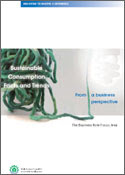
Just glancing at the title of the recently released report, Sustainable Consumption Facts and Trends, by the World Business Council for Sustainable Development (WBCSD) it might seem that sustainable and consuming are two topics that just do not go together. However, the report points out that the present level of consumption by Western nations is putting stress on the Earth's ecosystems.
What can businesses do to "mainstream" sustainable consumption? The report lists three different business approaches to sustainable consumption:
Innovation--Creating business processes for developing sustainable product and services.
Choice influencing--Using marketing and awareness-raising campaigns to encourage consumers to purchase sustainable products.
Choice editing--Removing unsustainable products and services from the marketplace.
There are several ways to create markets for sustainable products, according to the report:
1. Certification
2. Direct payments which create incentives for resource managers
3. Tradable permits
Policies that encourage sustainable consumption are needed. In 2007 the WBCSD developed policy recommendations that include: encouraging energy efficiency, a greater range of transportation fuels, and making consumers more aware of sustainable products and lifestyles.
Consumers are concerned about the environment, yet their concern does not always translate to their purchases. The report cites the following barriers: availability, affordability, convenience, product performance, conflicting priorities, skepticism and force of habit. If a product is cost-efficient and convenient, consumers are more likely to purchase it.
The report also lists ways to encourage sustainable consumption:
1. Make it easy and affordable for consumers to purchase sustainable products.
2. Make sustainable products available and comparable.
3. Increase the availability of more sustainable products and services.
4. Create a market for sustainable products by working with consumers.
5. Use marketing communications to influence consumer choice and behavior.









No comments:
Post a Comment